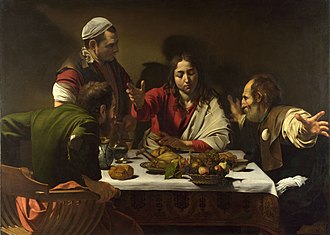Christian art
Christian art refers to the visual arts produced in an attempt to illustrate, supplement and portray in tangible form the principles of Christianity. Though Christian art is considered to have taken different forms throughout the ages, it has always been intrinsically linked to the liturgical and communal aspects of Christian worship and practice. The history of Christian art can be divided into two major periods: the pre-Constantinian era and the post-Constantinian era, with the latter witnessing a significant transformation in the acceptance and expansion of Christian-themed art.
History
The earliest examples of Christian art date back to the 2nd and 3rd centuries AD, found in the catacombs of Rome, where Christians buried their dead. These early works were simple and symbolic, often incorporating the Ichthys (fish symbol), the Good Shepherd, and the Chi-Rho, among others. The legalization of Christianity by the Edict of Milan in 313 AD under Emperor Constantine the Great marked a turning point, leading to the flourishing of Christian art. The construction of grand churches and basilicas provided vast new spaces for elaborate mosaics, frescoes, and sculptures.
Themes and Symbols
Christian art encompasses a wide range of themes, including biblical narratives, the life and teachings of Jesus Christ, the Virgin Mary, saints, and angels. Central themes also include the Crucifixion, the Resurrection, and the Last Supper, which have been depicted in countless variations throughout history. Symbols such as the cross, the lamb, and the dove represent key aspects of Christian theology and are recurrent motifs in Christian art.
Media and Forms
Christian art has been expressed through a variety of media, including painting, sculpture, mosaic, stained glass, and manuscript illumination. Early Christian art focused on wall paintings in catacombs and small items like the sarcophagi. The Byzantine Empire contributed significantly to Christian art, especially in the form of mosaics and icons, which became central to Orthodox Christian worship. The Renaissance period saw a resurgence in the depiction of religious themes, with artists like Leonardo da Vinci, Michelangelo, and Raphael creating works that remain pivotal in the history of art.
Contemporary Christian Art
In the modern era, Christian art has continued to evolve, reflecting changes in artistic styles and the diverse practices of Christianity across the globe. Contemporary Christian art often explores traditional themes with new techniques and perspectives, ranging from abstract interpretations of biblical stories to realistic portrayals of Christian figures and events.
Impact and Controversy
Christian art has not been without its controversies, particularly regarding the interpretation of religious themes and the use of religious images in worship, which was a central issue in the Iconoclasm disputes of the 8th and 9th centuries. Despite such challenges, Christian art has played a significant role in cultural exchange and the spread of Christianity, serving as a means of education and inspiration for both believers and non-believers alike.
See Also
Transform your life with W8MD's budget GLP-1 injections from $125.
W8MD offers a medical weight loss program to lose weight in Philadelphia. Our physician-supervised medical weight loss provides:
- Most insurances accepted or discounted self-pay rates. We will obtain insurance prior authorizations if needed.
- Generic GLP1 weight loss injections from $125 for the starting dose.
- Also offer prescription weight loss medications including Phentermine, Qsymia, Diethylpropion, Contrave etc.
NYC weight loss doctor appointments
Start your NYC weight loss journey today at our NYC medical weight loss and Philadelphia medical weight loss clinics.
- Call 718-946-5500 to lose weight in NYC or for medical weight loss in Philadelphia 215-676-2334.
- Tags:NYC medical weight loss, Philadelphia lose weight Zepbound NYC, Budget GLP1 weight loss injections, Wegovy Philadelphia, Wegovy NYC, Philadelphia medical weight loss, Brookly weight loss and Wegovy NYC
|
WikiMD's Wellness Encyclopedia |
| Let Food Be Thy Medicine Medicine Thy Food - Hippocrates |
Medical Disclaimer: WikiMD is not a substitute for professional medical advice. The information on WikiMD is provided as an information resource only, may be incorrect, outdated or misleading, and is not to be used or relied on for any diagnostic or treatment purposes. Please consult your health care provider before making any healthcare decisions or for guidance about a specific medical condition. WikiMD expressly disclaims responsibility, and shall have no liability, for any damages, loss, injury, or liability whatsoever suffered as a result of your reliance on the information contained in this site. By visiting this site you agree to the foregoing terms and conditions, which may from time to time be changed or supplemented by WikiMD. If you do not agree to the foregoing terms and conditions, you should not enter or use this site. See full disclaimer.
Credits:Most images are courtesy of Wikimedia commons, and templates, categories Wikipedia, licensed under CC BY SA or similar.
Contributors: Prab R. Tumpati, MD






